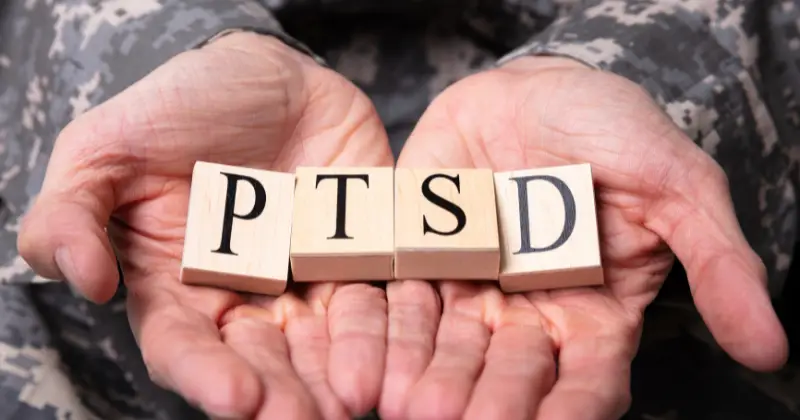Coping with post-traumatic stress disorder (PTSD) often leaves individuals feeling alone and overwhelmed. As a person who has grappled with this condition, I can attest to the obstacles encountered on the road to healing. “PTSD and the 12 Steps” is an approach that has been transformative for numerous people, including me, by incorporating the principles of the 12-step program initially developed for addiction recovery. This method has demonstrated remarkable advantages for that processing trauma too.
Incorporating the 12 steps into my PTSD recovery family therapy plan offered me a structured and supportive framework to work through the emotional, behavioral therapy, and psychological challenges that arose in the aftermath of my traumatic experiences. By following this tailored, mindful, and growth-oriented treatment approach, I have found a renewed sense of purpose and an improved mental health outlook. For the families of those grappling with PTSD symptoms, the 12-step program is a valuable resource to consider during the healing family therapy process.
Understanding PTSD

Diagnosis
When it comes to diagnosing PTSD, it’s essential to consult with a specialist in mental illness, such as a psychiatrist or psychologist. These professionals can determine if an individual is experiencing PTSD by examining specific symptoms that must be present for at least one month. It’s crucial to work with someone experienced in helping those with mental illnesses for an accurate diagnosis (NIMH).
Symptoms of PTSD
In my experience, individuals with PTSD usually exhibit a variety of symptoms that can be grouped into three main categories:
- Re-experiencing symptoms: These include flashbacks, nightmares, or intrusive memories of the traumatic event. It’s common for individuals to feel as though they are reliving the trauma repeatedly.
- Avoidance symptoms: People with PTSD often avoid situations, places, or people that remind them of the traumatic event. This avoidance can lead to social isolation or other significant lifestyle changes.
- Arousal and reactivity symptoms: Individuals with PTSD may experience heightened anxiety, irritability, difficulty sleeping, or hypervigilance. This heightened state of alert can disrupt daily functioning [((source)](https://www.ptsd.va.gov/understand/awareness/understand_ptsd.asp).
Trauma and PTSD
PTSD is a mental health problem that can develop after experiencing or witnessing a life-threatening event, such as combat, natural disasters, car accidents, or sexual assault (source). No one is immune to developing PTSD; it can affect the mental health of people of any age or background.
Coping with trauma and the development of PTSD can vary greatly from person to person. Some people might naturally be more resilient or have strong support systems in place, while others might be more vulnerable due to factors like a history of anxiety or depression. It’s worth noting that if someone suffers from PTSD, it’s not a sign of mental illness or weakness; rather, it’s a reaction to a deeply distressing event that has overwhelmed their ability to cope.
For individuals suffering from PTSD, finding a suitable treatment approach is crucial for recovery. One such treatment method for PTSD recovery is utilizing a 12-step approach, which can provide a new way of life for those struggling with PTSD and help them learn to cope with their symptoms (source).
Here is a helpful video:
PTSD and Addiction
The Connection
As someone who has studied PTSD and alcohol addiction, I’ve often observed a strong connection between the two. Many individuals suffering from post-traumatic stress disorder (PTSD) are at risk for developing addictive behaviors, using alcohol, often as a coping mechanism to deal with the overwhelming effects of trauma. The use of alcohol or drugs can temporarily numb the pain and anxiety, but in the long term, it only exacerbates the problem.
In fact, research on PTSD and addiction shows that there is a clear link between the two. Experiencing trauma, especially on a long-term basis, increases the chances of substance use disorders and abuse, which can further complicate the recovery process. Understanding the connection between PTSD and addiction is crucial in finding effective treatments for both conditions.
Treatment of Addiction
When it comes to treatment options for individuals struggling with both PTSD and addiction, finding a comprehensive approach is essential. This often involves addressing the root cause, which is the trauma, while simultaneously managing the addiction.
One approach that has shown promise is the use of the 12-step program. Although it was initially developed for alcoholism, the 12-step approach can be adapted for drug use and individuals with PTSD as well. I came across an interesting article on using a 12-step approach for substance use disorders PTSD recovery, which discusses how this method can be beneficial for people struggling with both conditions. By combining evidence-based treatments like trauma-focused therapy, cognitive-behavioral therapy, or EMDR therapy with the support and structure of a 12-step program, individuals can overcome their addiction and work towards healing from their trauma.
In my observations of individuals working through these programs, I’ve seen that the combination of addressing both the addiction and the trauma helps in the overall health and healing process. It’s important to understand that recovery from PTSD and addiction takes time, patience, and a strong support system, but with dedication and the right tools, it is possible to regain control and live a healthier, happier life.
As a side note, if you or someone you know has PTSD and is struggling with drug addiction treatment alone, I highly recommend exploring different treatment options and considering how the 12 steps could potentially fit into a healing journey.

Adaptable nature of twelve-step programs
Twelve-step programs have been around since the 1930s and have been adapted to help individuals with a variety of addictions, disorders, and mental health conditions. They are based on the principles of self-help, group support, and spiritual growth. While they were initially designed for those struggling with drug and substance abuse and alcohol use and addiction treatment alone, they have been adapted to help individuals with PTSD disorders and other mental health conditions.
Basic tenets of 12-step programs
The basic tenets and principles of 12-step programs are rooted in self-reflection, self-improvement, and community support. The 12 steps are a guide for individuals looking to overcome their addiction or mental illness, or health condition. They focus on accepting one’s imperfections, seeking growth through self-reflection, and finding stability through altruism and community service.
- Imperfection and Progress: The first step in any 12-step program is admitting one’s powerlessness over their addiction or mental health condition. This step emphasizes the importance of accepting one’s imperfections and recognizing that progress is a gradual process.
- Self-Searching for Growth: The second step involves a belief in an external source of power, such as a higher power or spiritual entity. This step emphasizes the importance of self-reflection and seeking growth through personal development.
- Ongoing Self-Reflection: The third step involves seeking and accepting community assistance. This step emphasizes the importance of seeking support from others and recognizing the value of community.
- Stability through Altruism and Community: The fourth step involves taking a fearless self-evaluation of one’s actions and emotions. This step emphasizes the importance of taking responsibility for one’s actions and the impact they have on others.
Understanding the Vagueness of 12-Step Programs

One of the criticisms of 12-step programs for addiction is their vagueness. The steps are open to interpretation, and different individuals may have different understandings of them. However, this vagueness can also be viewed as a strength, as it allows for flexibility in adapting the steps to fit individual needs.
Different Life Stories
Each individual and family has a unique life story and set of circumstances that have led them and their family to where they and their family members are today. The 12 steps can be adapted to fit each individual and family’s unique needs and experiences.
Interpretation of the Steps
The interpretation of different types of steps can also vary based on the individual’s personal beliefs and experiences. For example, the second step, which involves a belief in god removing an external source of power and control, may be interpreted differently by different types of individuals based on their spirituality or lack thereof.
Adapting the Traditional 12 Steps for Trauma Survivors

For trauma survivors, the 12 steps may need to be adapted to fit their unique needs and mental wellness. Trauma can cause individuals to feel unsafe and trigger traumatic memories, making some steps more challenging to navigate. However, with some practice and some adaptations, the 12 steps can still be a helpful tool for trauma recovery.
Sanding Down Sharp Edges and Corners
The 12 steps can be adapted by “sanding down” some of the sharp edges and corners that may trigger traumatic memories. For example, the fourth step of the big book, which involves a fearless self-evaluation, can, for example, be adapted to focus aa members more on self-acceptance and self-compassion.
Softer Approach for PTSD
A softer approach to counseling and treatment may also be necessary for individuals with PTSD. This may involve taking a slower pace with treatments, focusing more on their health and self-care, and incorporating coping strategies such as mindfulness and whole-body relaxation techniques.
PTSD 12 Steps

As a former mental health services professional, I have seen the benefits of adopting the 12 steps for trauma survivors. Below are my preferred steps for trauma recovery:
Step 1: Recognizing the Lack of Internal Power
The first step involves recognizing the lack of internal power and accepting one’s imperfections. This step is crucial for trauma survivors, as it emphasizes the importance and power greater the practice of self-acceptance and recognizing that progress is a gradual process.
Step 2: Belief in an External Source of Power
The second step of spiritual awakening or mental awakening or mental awakening involves a belief in an external source of power, such as a higher power or spiritual entity. This step can be adapted to fit each individual’s personal beliefs and spirituality.
Step 3: Seeking and Accepting Community Assistance
The third step involves seeking and using the service and support groups and accepting community assistance. This step emphasizes the importance and effectiveness of seeking support from others and recognizing the value higher power of community service and support groups.
Step 4: Fearless Self-Evaluation
The fourth step involves taking a fearless self-evaluation and knowledge of the exact nature of one person’s actions and emotions. This step can be adapted to focus more on self-acceptance and self-compassion.
Step 5: Admitting Inappropriate Actions and Emotions
The fifth step involves a person admitting inappropriate actions and emotions. This step emphasizes the importance of taking responsibility for one person or family other’s actions and behaviors and the impact they have on the lives of others.
Step 6: Understanding and Discussing Defects and Emotions
The sixth step involves understanding symptoms and discussing all these defects both in the body, behavior, and emotions. This step can be adapted to other disorders and focus more on self-compassion and self-care.
Step 7: Managing Shortcomings and Forgiveness
The seventh step involves managing shortcomings and forgiveness. This step emphasizes the importance of self-compassion and forgiveness.
Step 8: Listing People Harmed and Willingness to Make Amends
The eighth step involves listing people harmed and being willing to make amends. This step emphasizes the importance of taking responsibility for one’s actions and the impact they have on others.
Step 9: Making Amends When Appropriate
The ninth step involves making direct amends when appropriate. This step emphasizes the importance of taking action to repair relationships with others.
Step 10: Continual Personal Inventory and Communication
The tenth step involves continual personal inventory and communication. This step emphasizes the importance of ongoing self-reflection, self-esteem, and communication with others.
Step 11: Seeking Guidance and Internal Strength through Calming Techniques
The eleventh step involves the person seeking guidance and internal strength through calming techniques, counseling conscious contact with such people, and behaviors such as meditation or prayer. This step emphasizes the importance of self-care and finding inner peace.
Step 12: Sharing the Message and Practicing Guiding Principles in Daily Life
The twelfth step involves sharing the message and practicing guiding principles in all our affairs of daily life. This step emphasizes the importance of community service and practicing the principles of self-improvement daily.
Conclusion
The 12 steps can be a helpful tool for trauma and mental illness survivors in their healing journey. However, it is essential to adapt the steps to fit each individual’s unique needs. Adapting the steps may involve taking a softer approach and focusing more on self-acceptance and self-compassion. It is crucial to recognize the importance of seeking support from others and finding community in the recovery process. I encourage anyone struggling with trauma or mental illness to embark on their healing journey and seek the support they need.
CTA
If you or someone you know is struggling with trauma, I encourage you to seek support. Reach out to a mental health professional, join a support group, or consider adapting the 12 steps to fit your unique and your mental health needs. Remember, healing is a gradual process, but with the right support and tools, it is possible.
Discover the power of our adaptable 12-step program, designed with your unique journey in mind.
